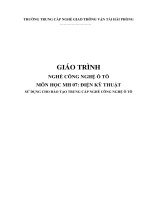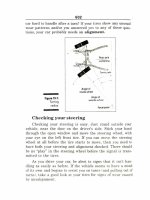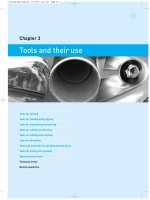Sách dạy nghề ô tô (tập 1) (Automotive mechanics volume I, part 1 to part 6)
Bạn đang xem bản rút gọn của tài liệu. Xem và tải ngay bản đầy đủ của tài liệu tại đây (58.67 KB, 11 trang )
Automotive Mechanics Volume I (Part 1 to part 6)
(Missing chap 14, 16-22, 26, 27. 29 -31, 34)
Automotive Mechanics: Volume I
The seventh edition of Automotive Mechanics has been completely revised. It is a
comprehensive automotive text, consisting of two volumes that relate to
passenger and light commercial vehicles. The text covers principles, applications
and general servicing requirements.
Volume 1 commences with an introduction to motor vehicles which includes
workshop practices and the use of tools. It then covers engine operation; engine
systems; manual transmissions; drives; running gear; suspension; steering and
general maintenance requirements. It concludes with electrical fundamentals and
basic electrical systems.
Volume 2 covers engine construction and overhaul; fuel and engine
management; diesel engines; automatic transmissions; four-wheel drive; engine
electrical systems; body electrics and also a number of vehicle safety, security
and convenience systems.
Volume 1, with its early introductory chapters, is useful for the earlier stages of a
course, while Volume 2, with some of the more advanced material, is suitable for
some of the later stages. However, each volume is complete with all related
material for its topics - principles, applications, construction of components and
basic servicing requirements are all located conveniently within the same
volume.
Both books are easy to use. There is a brief contents list as well as a detailed
contents list at the front of each volume. Also, each volume is divided into a
number of parts with a contents list at the start of each part. Further, the main
topics for each chapter are shown at the start of the chapter. A glossary and a
comprehensive index are provided for each volume. All these features enable
information to be quickly located.
These two volumes of Automotive Mechanics provide a valuable resource for all
automotive students. They would also have an important place in any automotive
technician's library. While Automotive Mechanics does not attempt to replace
vehicle manufacturers' manuals, these volumes do provide a general resource
that complement them.
Contents
Preface
Acknowledgments
xiii
xiv
Part 1 ∙ Introduction to motor vehicles
1
Motor vehicle components
Mechanical arrangements
Sections of a motor vehicle
The engine assembly
Vehicle construction
The drive train
Transmissions
Running gear
Electrical system
Body and associated parts
Names of components and parts
Technical terms
Review questions
3
4
4
5
5
6
9
10
13
13
15
15
15
2
17
Workshop practices
Automotive service procedures
Workshop operations
Production processes
Fasteners
Locking devices
Screw threads
V-threads
Workshop manuals
Vehicle identification
Technical terms
Review questions
18
20
21
23
25
26
27
28
30
30
30
3
Tools and their use
Tools for turning
Tools for holding and gripping
Tools for hammering and driving
Tools for cutting and forming
Tools for drilling and reaming
Tools for threading
Tools and materials for grinding and abrading
Tools for pulling and pushing
Special service tools
Technical terms
Review questions
33
34
38
39
41
44
46
48
51
51
51
51
4
Measuring and checking
Measuring instruments
Micrometers
Reading micrometers
Accuracy and care of micrometers
Vernier calipers
Dial gauge and its use
Depth gauges
Marking and checking
Tools for marking and checking
Other gauges and instruments
Electrical test instruments
Technical terms
Review questions
53
54
55
57
59
59
60
61
61
62
65
66
67
67
5
Friction and bearings
Friction
Types of friction
Making use of friction
Bearings
Plain bearings
Antifriction bearings
Special types of bearings
Removing and installing bearings
Cleaning and checking bearings
Bearing adjustments
Bearing failures
Antifriction bearing defects
Technical terms
Review questions
69
70
70
71
71
73
74
76
77
78
79
80
81
83
83
6
Seals, gaskets and sealants
Purpose of oil seals
Types of oil seals
Servicing oil seals
Gaskets
Gasket materials
Handling and storing gaskets
Sealants and sealing compounds
Installing gaskets
85
86
86
88
91
92
93
93
93
How to make a gasket
Pipes, hoses and connections
Technical terms
Review questions
7
Workshop safety
Personal safety
Safety with machines and equipment
Safety with motor vehicles
Safety with vehicle components
Safety with engines
Safety with batteries
Fire safety
Fires 103
Fire extinguishers
First aid
Technical terms
Review questions
95
95
96
96
97
98
99
99
101
101
102
103
104
105
105
105
Part 2 ∙ Engines and engine systems
8
Engine fundamentals
Actions within a cylinder
Reciprocating to rotary motion
Cycles of engine operation
Four-stroke cycle (petrol engine)
Two-stroke cycle (petrol engine)
Diesel engine operation
Rotary engine
Multicylinder engines
Engine classifications
Engine systems
Technical terms
Review questions
109
110
110
112
112
116
118
119
119
121
122
122
123
9
Engine construction and components
Engine construction
Components of an engine assembly
Engine features
Working on engines – general
Working on the underside of the engine
Working on the front of the engine
Working on the top of the engine
Working on engine ancillaries
Working on engine electrical systems
Technical terms
Review questions
125
126
129
130
132
135
136
136
138
139
141
141
10 Cooling system and service
Basic cooling system
Heat and temperature
Heat transfer
Liquid-cooling systems
Cooling-system components
Radiator assembly
Radiator pressure cap and reservoir
Coolant
Cooling-system service
Cooling-system repairs
Water pump overhaul
Cooling-system problems
Trouble diagnosis guide
Technical terms
Review questions
143
144
145
146
146
148
152
153
154
155
158
160
161
162
162
162
11 Engine-lubricating systems
Engine lubrication
Oil circulation
Oil pumps
Oil pump service
Oil filters
Oil coolers
Lubrication of engine bearings
Crankcase ventilation
Lubricating-system maintenance
Lubricating-system problems
Technical terms
Review questions
163
164
165
167
169
170
171
173
174
175
177
178
178
12 EFI fuel systems
Petrol as a fuel
Air–fuel ratio
Types of EFI systems
Basic multipoint EFI system
Multipoint fuel systems
Fuel-supply system components
Air intake system components
Electronic control components
Checks and precautions
Service requirements
Technical terms
Review questions
179
180
180
181
181
181
184
189
190
191
193
193
193
13 Carburettor fuel systems
Carburettor fuel system
Carburettors
Air and fuel flow in a carburettor
Carburettor operation
Carburettor systems
Carburettor construction
General carburettor design
Carburettor external construction
Carburettor service and checks
Basic carburettor problems
Servicing fuel pumps
Testing mechanical fuel pumps
Checking electric pumps
Fuel system problems
Technical terms
Review questions
195
196
198
199
199
201
201
203
204
205
207
207
208
210
210
211
211
14 Gas fuel systems
Gas-fuelled vehicles
LPG and NGV
Location of LPG components
LPG fuel tank assembly
Fuel tank sub-compartment
Fuel filler assembly
Components of the supply subsystem
Converter assembly
Air–gas mixer
LPG fuel system controls
LPG fuel system components
Converter with stepper motor
NGV fuel systems
Servicing LPG fuel systems
Safety precautions with gas
Technical terms
Review questions
213
214
214
215
216
217
219
220
220
223
224
224
225
227
228
229
230
230
15 Intake and exhaust systems
Air cleaners
Carburettor air cleaners
EFI air cleaners
Diesel air cleaners
Air-cleaner service
Engine manifolds
Intake-system problems
Exhaust systems
Exhaust-system service
Exhaust-system problems
Technical terms
Review questions
231
232
232
234
236
236
238
240
240
243
244
246
246
Part 3 ∙ Manual transmissions and drives
16 Clutches
Purpose of the clutch
Types of clutches
The clutch assembly
Diaphragm clutch operation
Diaphragm clutch components
Clutch controls
Other clutch features
Pull-type clutches
Clutch with central release
Dual-mass flywheel
Technical terms
Review questions
249
250
250
250
251
252
255
258
259
260
260
261
262
17 Clutch service
General checks and adjustments
Adjusting mechanical controls
Servicing mechanical controls
Adjusting hydraulic controls
Servicing hydraulic controls
Bleeding the clutch system
Major clutch service
Repairs to pressure-plate assemblies
Clutch housing alignment
Analysing clutch problems
Diagnosing clutch noise
General clutch problems
Technical terms
Review questions
263
264
264
265
265
266
269
269
273
273
273
274
275
276
276
18 Manual transmissions and transaxles
Purpose of a transmission
Types of gears
Gear ratio
Basic transmission
Basic transmission power flow
Sliding and synchromesh gears
Basic synchromesh transmission
Five-speed synchromesh transmission
Power flow through a five-speed transmission
Transaxles
Transaxle construction
Transaxle operation
Synchromesh operation
Types of synchromesh
Gearshift mechanisms
Technical terms
Review questions
277
278
278
279
280
281
281
283
285
286
286
286
290
293
295
295
300
300
19 Manual transmission and transaxle service 301
Service operations
302
Rear-wheel-drive transmissions
303
Dismantling transmissions
307
Dismantling and checking components
307
Identifying internal components of a transmission
311
Transaxles
312
Identifying internal components of a transaxle
313
Dismantling transaxles
316
Reassembling transaxles
317
Inspection of parts (all transmissions)
317
Points relating to reassembly
319
Removing transmissions and transaxles
321
Transmission and transaxle fault diagnosis
321
Road testing and diagnosis
321
Transmission service summary
322
Technical terms
324
Review questions
324
20 Drive lines and shafts
Rear-wheel drive
Universal joints
Constant-velocity joints
Alignment of universal joints (RWD)
Removing and replacing propeller shafts
Servicing cross-and-yoke joints
Servicing a Löbro joint
Front-wheel drive
Constant-velocity joints (FWD)
Servicing constant-velocity joints (FWD)
Technical terms
Review questions
325
326
326
328
329
330
331
334
335
336
337
340
340
21 Rear axles and final drives
Basic rear-axle assembly (RWD)
Rigid rear axles
Final drive and differential
Axle shafts for rigid rear axles
Rear-axle bearings
Differential
Limited-slip differentials
Rear axles for independent rear suspension
Transaxle final drive
Four-wheel drive
Technical terms
Review questions
343
344
344
346
349
349
350
352
355
357
359
359
359
22 Rear-axle and final-drive service
General rear-axle service points
Removing axle shafts and bearings
Servicing differential assemblies
Servicing a banjo-axle differential
Servicing unitised rear-axle differentials
Servicing IRS final drives
Crown wheel and pinion adjustments
Checking gear tooth contact
Bearing preload – pinion and side bearings
Limited-slip differential service
Transaxle final-drive service
Transaxle with crown wheel and pinion
Summary of differential adjustments
Diagnosis of rear-axle noises
Technical terms
Review questions
361
362
362
367
367
371
372
374
376
377
379
380
380
381
381
382
382
Part 4 ∙ Running gear
23 Tyres, wheels and balance
Tyre construction
Types of tyre construction
Characteristics of tyres
Tyre profiles
Tyre sizes and identification
Tyre tread patterns
Australian Design Rules
Tyre wear
Tyre rotation
Wheels
Removing and fitting tyres
Light-truck wheels and tyres
Wheel balance
Balancing wheels
Technical terms
Review questions
387
388
389
389
390
391
392
393
394
396
396
398
399
400
402
404
404
24 Brakes
Basic brake system
Hydraulic principles
Brake hydraulic systems
Master cylinders
Compensating-type master cylinder
Centre-valve master cylinder
Valves in the hydraulic system
Wheel cylinders
Hydraulic brake fluid
Brake booster
Drum-brake assemblies
Brake-shoe assemblies
Disc-brake assemblies
Parking brakes
Technical terms
Review questions
407
408
408
410
410
413
414
416
418
420
420
423
424
426
430
432
432
25 Brake service
Maintenance and inspection
Brake booster
Hydraulic system – service points
Bleeding brakes
Master cylinder service
Drum-brake service
Drum-brake adjustments
Self-adjusting drum brakes
Disc-brake service
Parking brakes
Brake tools
Fault diagnosis
Technical terms
Review questions
435
436
438
439
441
442
443
446
447
448
451
453
454
455
455
26 Antilock braking systems (ABS)
Overview of ABS
Main system components
Hydraulic system
Electronic system
Hydraulic operation
Complete four-channel system
Summary of ABS operation
Fault diagnosis
Technical terms
Review questions
457
458
458
460
461
462
463
464
466
466
466
27 Suspension systems
General suspension designs
Leaf springs
Rear suspension with leaf springs
Front suspension with leaf springs
Types of coil springs
Front suspension with coil springs
Strut or McPherson suspension
Rear suspension with coil springs
Independent rear suspensions with struts
Rear suspension with swing axles
Torsion rear axle
Torsion bar suspension
Shock absorbers
Height-control suspension
Technical terms
Review questions
469
470
471
471
473
474
474
476
477
479
480
480
483
483
486
486
487
28 Suspension service
Maintenance
Dismantling and reassembling procedures
Ball joint front suspension
Strut (McPherson) suspensions
Rigid rear axle with coil springs
Independent rear suspension (RWD vehicles)
Rigid rear axle with leaf springs
Dismantling and reassembling struts
Servicing components
Servicing hubs and bearings
Hubs with tapered roller bearings
Hubs with unitised bearings
Other bearing arrangements
Checking suspension parts
Servicing shock absorbers
Technical terms
Review questions
489
490
490
491
492
494
495
496
498
499
502
502
504
506
507
509
510
510
29 Steering systems
Steering systems
Rack-and-pinion steering systems
Steering systems with worm gearing
Steering and suspension angles
Steering boxes
Rack-and-pinion steering boxes
Rack-and-pinion power steering
Rack-and-pinion power steering components
Speed-sensitive rack-and-pinion power steering
Electro-hydraulic power steering
Electric power steering
Steering boxes with worm gearing
Power steering for worm-type boxes
Four-wheel steering
Four-wheel-steering systems
Four-wheel steering with rear power cylinder
Other steering features
Technical terms
Review questions
511
512
512
513
514
516
517
518
519
521
522
523
524
525
528
529
530
533
534
534
30 Steering-system service
Servicing steering linkage
Steering-column service
Power-steering maintenance
Rack-and-pinion steering service
Rack-and-pinion power-steering service
Analysing power-steering problems
535
536
538
540
542
545
547
Servicing a recirculating-ball steering box
Worm-type steering box adjustments
Recirculating-ball box with power steering
Steering faults
Technical terms
Review questions
547
550
551
551
552
552
31 Wheel alignment
Steering and suspension angles
Front-suspension and steering adjustments
Caster and camber adjustments
Toe adjustments
Adjustments for toe-out-on-turns
Rear-suspension adjustments
Wheel-alignment equipment
Types of wheel aligners
Using wheel aligners
Front-wheel alignment
Rear-wheel alignment
Function and effects of the various angles
More about suspension angles
Technical terms
Review questions
553
554
556
556
558
560
560
561
562
565
568
568
569
571
572
572
Part 5 ∙ Maintenance
32 Fuels, fluids and lubricants
Crude oil and its products
Petrol
Gas fuels
Automotive diesel fuels
Alternative fuels
Lubricating oil
Grease
Transmission oils
Hydraulic brake fluids
Technical terms
Review questions
577
578
578
580
581
582
582
585
586
587
588
588
33 Service and maintenance
Servicing new vehicles
New vehicle services
Scheduled maintenance services
Maintenance items
Service intervals
Special services
General service and repairs
Lifting and jacking
Towing and recovering
Technical terms
Review questions
589
590
590
590
592
597
598
598
598
600
601
601
34 Basic mechanics and diagnosis
Diagnosis
Forces that produce stress
Failure analysis
Analysing shaft failures
Analysing fastener failures
Analysing excessive wear
Locating noise and looseness
Analysing gear problems
Bearing problems
Materials and their use
Other means of diagnosis
Technical terms
603
604
604
607
607
608
609
610
611
613
613
614
614
Review questions
614
Part 6 ∙ Basics of the electrical system
35 Basic electrics
Automotive electrical components
Nature of electricity
Electron flow
Current flow
Types of electrical materials
Summary of basic electrics
Practical conductors, resistors and insulators
Factors affecting current flow
The language of electricity
Electrical circuits
Parallel and series connections
Voltage drop in a circuit
Technical terms
Review questions
619
620
621
622
623
623
624
625
627
627
630
630
632
633
633
36 Effects and applications of electric currents 635
Effects of an electric current
636
Heating effect of a current
636
Chemical effect of a current
637
Magnetic effect of a current
638
Theory of magnetism
638
Electromagnetism
640
Solenoids and electromagnets
641
Electromagnetic switches (relays)
643
Electrical measuring instruments
644
Electromagnetic induction
645
Electric motors
648
Direct and alternating current
649
Technical terms
649
Review questions
649
37 Basic electronics
Electronics
Electronic semiconductors
Electronic components – diodes and transistors
Other electronic components
Use of electronic components
Electronic systems
Micro-computer
Body electronic module
Technical terms
Review questions
651
652
653
654
656
658
660
662
663
665
665
38 The battery
Materials in the battery
Battery construction
Chemical actions in the battery
Low-maintenance and maintenance-free batteries
Battery voltage
Battery specifications
Battery testing
Battery charging
Care of batteries in stock
Battery maintenance
Battery faults
Battery safety
Use of jumper leads
Technical terms
Review questions
667
668
668
669
671
671
671
672
674
675
675
677
678
678
680
680
Appendix: The SI system of measurement
Glossary
Index
681
687
699









